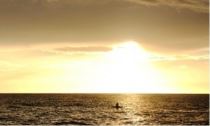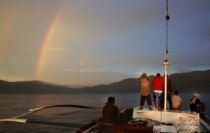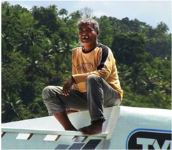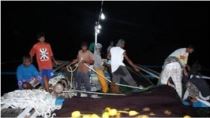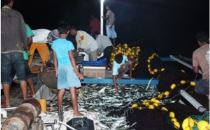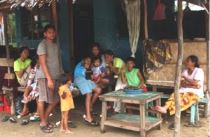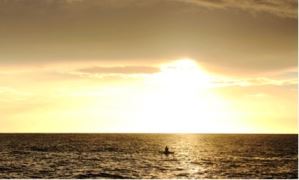
On April 9, 2012, F/B Ruaida, the fishing boat of the Sta. Maria Fisherfolks Association, in Siocon, Zamboanga del Norte, sailed for the first time on the town’s municipal waters and outlying areas. The boat was an endowment of TVI Resource Development (Phils.) Incorporated, (TVIRD) to the fisherfolk as a way of helping them improve their lives. Joseph Deliverio, a Public Affairs officer of the company was on board to chronicle the event. This is his story.
It was already late in the afternoon when our F/B (Fishing Boat) Ruaida cast off on her first fishing expedition. She slid gently toward the open sea. At this time, you will know that the night will soon set in an hour or two because of the damp and cold wind hitting your face. The sun glowed with yellow-orange rays, giving a striking contrast against the blue sky and the bluer ocean. The sun’s reflection turned part of the sea into gold, which was rendered more picturesque by the silhouette of a lone fisherman in his small boat sailing by. When you look at the other side, a rainbow displayed its colors vividly amidst the gently sloping hills that perched above the coastlines. Everybody on board savored the minute with reverence of nature at its best!
Now I know why these Muslim fishermen from Sta. Maria love the sea. For one, it is here that you will catch the magical moment of being one with nature, and in so doing, you commune with the Creator.
As our boat travelled farther, I looked around and beheld the splendor of the countryside and the sea. Maybe the town mayor was right when he claimed the place to be like paradise, I pondered. But on second thought, the place is not at all just simply a place of beauty and bounty. Like the rest of Mindanao, it has its own share of strife in the past, too.
Manning the wheel of the engine of F/B Ruaida is Tan Cailo, the captain of the fishing boat and the leader of his people. With his grayish-white hair and sun-burnt skin, you can tell that he is an old seahand. His genuine smile was a cue for me to get near him to strike a conversation. I asked where we were heading and he replied that the boat – classified as a Kubkoban in the dialect – will just cruise to fish along the coastlines of Baliguian, the town next to Siocon. After all, the boat was undergoing sea-trial and this trip was simply to test whether its engine and fishing gear really worked, he added.
Then he began to share snippets of his life.
He said that he was once a rebel combatant belonging to the then potent Muslim secessionist rebel group Moro National Liberation Front (MNLF). Not long after, he and many others, returned to the fold of the law and settled in peace as a fisherman in Sta. Maria, a fishing village along the coast of Siocon.
While he was talking, the night falls and the wind gets colder. All you can see around now is only your boat illuminated by five small fluorescent bulbs. The sixth larger and brighter light was focused directly on the waters below. There were many other fishing boats nearby from the faint lights blinking in the darkness. Cailo interrupted his conversation with barked commands to the crew. Suddenly, the 21-foot fishing boat’s crew girded for action. Some carefully unfolded the large fishnet. Others attended to the pulley mechanism, while one attended to the engine astern. The cook made dinner while another prepared coffee for everybody.
Each crew-member, including two youngsters, had specific roles to play. “In a fishing boat like this, the most important equipment is the crew,” explained Cailo. “Therefore, a boat owner or the captain must be very kind and fair to the crew at all times, otherwise they will leave you. How else can a crew catch regularly when there is no crew?” Cailo stressed.
Then he continued with his story.
Cailo became an elected councilman in his village inhabited mostly by Muslim Tausugs. The word Tausug means ‘brave seafarer’. As a leader, he knew exactly that he was waging an entirely different war against the perennial enemy – poverty. Besides, he knew too that poverty was one of the reasons why he joined the rebels before.
“Without your own big fishing boat, you only get fish just enough to feed your family for a day,” Cailo said. A crewman agreed and added, “Before this, I used to fish using hook and line with a very small paddleboat. You could get four kilos at most in a day’s catch.”
The boat slowed down and we all shared a dinner of freshly-grilled fish and hot rice with steaming coffee.
Cailo admitted that he has long dreamt of having a Kubkoban. It was the only answer to relieving his constituents from hardship and want. ”With this type of a fishing boat, you can go as far as the Sulu Seas and get a big catch. It may be costly to build but you will surely get a return on your investment in less than a year,” he explained. The Kubkoban we were on took P2.8-M to build. He said that a similar boat hauled in P100,000 worth of fish after two days of fishing a week ago. “What if you can do that twice in a week? Then you’d be earning P800, 000 a month!” declared Cailo.
Once he convinced a wealthy relative to finance a Kubkoban venture. “I will let you run my Kubkoban. All you have to do is remit to me its profits until everything I have invested in building the boat is returned. You can have the boat after that,” said the relative. In just 6 months, Cailo was just about ready to pay the loan but had a falling out with his relative. He ended up dry and beached without a boat.
At this point, the boat turned around and the crew got excited because they were ready to haul in their catch. The moment has finally arrived when the crew will have to prove their mettle as fishers of the sea and for Ruaida to prove her worthiness as a fishing boat.
F/B Ruaida is collectively-owned by Tan Cailo, the crew, and around 50 other members of the Sta. Maria Fisherfolks Association, Inc. (SMFAI). In fact, they build it themselves for almost a year right after the company, TVI Resource Development (Phils) Inc., agreed to make the project part of its social commitment to promote sustainable development in communities where they operate. The company operates a copper-zinc mine in Siocon but uses the Sta. Maria wharf as the port for shipping its copper and zinc concentrates to buyers. The year of construction, preparation, and anticipation reached its peak at this moment.
The boat slowed and all its lights were shut. The complete darkness made me playfully think that maybe, hell might not be a fiery furnace after all as I was made to believe when I was a kid. But rather, it’s a very cold void of utter blackness that engulfs you overwhelmingly while you eternally strive to keep balance on a slippery platform that sways to and fro, and jerks side by side, not wanting to fall overboard and die either by drowning or by hypothermia, or both.
Suddenly, a blinding beam of light came from a small paddleboat called a banca. Cailo said the light attracts the fish milling below around the glowing lamp. Gently, the crew lowers the fishnet while the Ruaida slowly surrounds the banca until the yellow-buoyed fishnet makes a circle 30-meter in diameter to trap the fish.
The lights came and the engine hummed harder. The engine below deck slowly pulled the net back to the boat with the help of the crew.
Then I saw something–a fish that was tossed on the boat’s floor. Right after, I saw another, and then some more. Amidst the shouts of excitement and laughter of the crew, silvery fish began to fill the boat’s deck. At first, you can count them. But as the crew pulled more, they gathered hundreds, shaking and wriggling on the deck. Eventually when the entire bulk of the net was hauled in, the flip-flopping fish formed a big mound! Prosperity was in full view with the big catch and the even bigger smiles of the crew.
F/B Ruaida turned out to be a fishing boat after all. Exhausted, I slept in a corner after experiencing my first fishing expedition.
Early next morning, April 9, we steered for home. The crew was tired because of lack of sleep. Nevertheless, their smiles were as bright as the morning sun. In good spirits, we gathered around the grille and had our breakfast. Others were sipping coffee and smoking astern.
Tan Cailo smilingly reported that last night’s haul was worth P33,000. Not bad, considering that it was only a test run. Then he told me how he will divide the income fairly among the crewmembers. Of course, funds will be set aside for the next voyage, for maintenance, for the association, and for the required 3% plowback for the company. Fair enough, I thought.
“I can’t thank the company enough for giving us this boat. We have dreamt of this since before and now it’s here. I meant it when I said to them that this will greatly help my people. I will not fail the company,” Cailo said.
We docked near the sands of Sta. Maria, where all of the crew lived. I spent some moments chatting with the crew’s wives and children who were just as happy. I looked for Ruaida, the young woman the boat is named after. Gazing from a window was the Muslim teen-ager who smiles and talks willingly to a stranger, yet keeps her distance. She strikes me as a budding flower in the midst of a bland, barren, and monotonous landscape of poverty. For me, she represents the village’s renewed hope for a better life.
Like the girl she is named after, the boat, too, symbolized the collective sentiment of its people: To clear the vestiges of the troubled past for peace to endure. (Joseph Arnel Deliverio. The author is a Public Affairs Officer of TVIRD, Canatuan Minesite, Siocon, Zamboanga del Norte. Before joining the company,he worked for quite some time as a journalist in Zamboanga Peninsula.)

